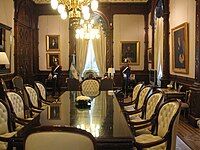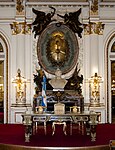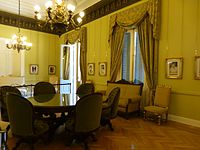Casa Rosada
| Casa Rosada | |
|---|---|
Eclectic | |
| Address | Balcarce 50 |
| Town or city | Buenos Aires |
| Country | Argentina |
| Coordinates | 34°36′29″S 58°22′13″W / 34.60806°S 58.37028°W |
| Current tenants | Government of Argentina |
| Construction started |
|
| Completed |
|
| Demolished | 1938 (partial) |
| Client | Government of Argentina |
| Owner | Government of Argentina |
| Technical details | |
| Floor count | 4 |
| Design and construction | |
| Architect(s) |
|
| Main contractor |
|
National Historic Monument of Argentina | |
The Casa Rosada (Spanish pronunciation: [ˈkasa roˈsaða]), literally the Pink House, is the president of the Argentine Republic's official workplace, located in Buenos Aires. The palatial mansion is known officially as Casa de Gobierno ("House of Government" or "Government House"). Normally, the president lives at the Quinta de Olivos, the president of Argentina's official residence, located in Olivos, Greater Buenos Aires. The characteristic color of the Casa Rosada is baby pink, and it is considered one of the most emblematic buildings in Buenos Aires. The building also houses a museum, which contains objects relating to former presidents of Argentina. It has been declared a National Historic Monument of Argentina.
History
The Casa Rosada sits at the eastern end of the
The old fort's administrative annex, which survived the construction of Taylor's Customs House, was enlisted as the presidential offices by
Presiding over an unprecedented socio-economic boom, President
A Historical Museum was created in 1957 to display presidential memorabilia and selected belongings, such as sashes, batons, books, furniture, and three carriages. The remains of the former fort were partially excavated in 1984–85, and the uncovered structures were incorporated into the Museum of the Casa Rosada. Located behind the building, these works led to the rerouting of Paseo Colón Avenue, unifying the Casa Rosada with Parque Colón (Columbus Park) behind it. Plans were announced in 2009 for the restoration of surviving portions of Taylor's Customs House, as well.[4]
During 2001 riots in Argentina as protesters converged on streets around the palace, and the president Fernando de la Rúa was forced to resign, he fled the its premises by a helicopter, enacting a resounding news story.[5]
The Casa Rosada itself in 2006 underwent extensive renovation delayed by the
Evolution of the Casa Rosada
The Fort
In 1536, Don Pedro de Mendoza established a settlement near the mouth of the Riachuelo de los Navíos, called Nuestra Señora del Buen Ayre. In 1580, Juan de Garay founded the city at the place which was to be the Plaza Mayor (nowadays Plaza de Mayo), naming it Santísima Trinidad while the port retained the name of the original settlement; the "Royal Fort of Don Juan Baltasar de Austria" was built in 1594. It was replaced in 1713 by a more solid construction with turrets, sentry boxes, a moat and a drawbridge that upon being completed in 1720 was given the name of "Castillo San Miguel" (St. Michael's Castle). President Bernardino Rivadavia modified the fort in 1820, and the drawbridge was replaced by a neoclassical portico. The site which was for defence purposes at that time and also seat of the Spanish and Home governments, is where Government House currently stands.[2]
In the Pink House Museum one of its cannon holes can be found in part of a storage room of the Royal Treasury's warehouse.[2]
New Customs House
Under the direction of the
The Post Office Palace
President
As Government House looked totally insignificant compared to this new post office building, President
The Palace
The outlay of the buildings is three stories on Balcarce Street and four stories plus a basement/galleries of Government House Museum, on Avenida Paseo Colón, practically covering the footage of a whole bloc. All the original rooms that are on the three main
Rooms
The president sits at his or her office on a seat known as the "Seat of Rivadavia". The seat itself did not actually belong to Bernardino Rivadavia, the first president of Argentina, but is instead a homage to the early statesman.[6]
The Hall of Busts houses marble busts of the many presidents of Argentina, made by diverse artists both national and international. The list, however, is not exhaustive, and subjected to political biases. President Néstor Kirchner ordered in 2006 the removal of all busts of presidents that took power during coups, but the busts of José Félix Uriburu, Pedro Pablo Ramírez and Edelmiro Julián Farrell were spared and finally removed during the administration of Mauricio Macri. President Cristina Fernández de Kirchner broke the timeline order of the busts, and placed instead the busts of Kirchner, Raúl Alfonsín, Hipólito Yrigoyen and Juan Perón in a prominent location. The administration of Macri reordered the busts under the supervision of the National Academy of History of Argentina, and Alberto Fernández restored the order set by Cristina Kirchner. The internal regulations specify that presidents should have a bust 8 years after they leave office, but for varied reasons Isabel Perón, Carlos Menem, Fernando de la Rúa, Adolfo Rodríguez Saá and Eduardo Duhalde do not have busts as of 2022.[7]
34°36′29″S 58°22′13″W / 34.60806°S 58.37028°W
Interior
-
The President's office
-
Christ the King Chapel
-
The Stained Glass Gallery
-
The Hall of Busts
-
The Palm Tree Patio
-
The Salón Blanco
-
The Salón Blanco
-
The North Hall
-
The South Hall
-
Hall of Argentine Bicentennial Women
-
Hall of Bicentennial Patriots of Latin America
-
Hall of Bicentennial Thinkers and Writers
-
Hall of Argentine Bicentennial Scientists
-
Hall of Argentine Bicentennial Painters and Paintings (Blue Hall)
-
Presidential elevator
-
Francia Stairs of Honour
-
Italia Stairs of Honour
-
Hall of Honour
Exterior
-
View from Plaza de Mayo
-
View of the north wing and the porte-cochère
-
Clock
-
Entrance on Rivadavia Street
-
The presidential balcony
-
View from Puerto Madero
-
The Italianate portico
-
Equestrian statue of Manuel Belgrano
-
Sculpture
-
Coat of arms of Argentina
See also
- Palace of the Argentine National Congress
- Palace of Justice of the Argentine Nation
- List of National Historic Monuments of Argentina
- President of Argentina
References
- ^ a b c d Museum of the Casa Rosada: history Archived June 22, 2012, at the Wayback Machine (in Spanish)
- ^ a b c d e f g Casa Rosada: History (in Spanish)
- ^ Daniel Lewis, "Casa Rosada" in Encyclopedia of Latin American History and Culture, New York: Charles Scribner's Sons 1996, vol. 2, p. 2 citing James R. Scobie, Argentina: A City and a Nation, 2d edition (1971) pp. 163, 165.
- Museo de La Plata(in Spanish). 2013.
- ^ "Trauma of Argentine 'great crisis' lives on 20 years later". The Sun. 17 December 2021. Retrieved 21 March 2024.
- ^ Cuando Rivadavia se fue con el sillón Archived 2010-04-13 at the Wayback Machine (in Spanish)
- ^ Camila Dolabjian (March 29, 2022). "Casa Rosada. Secretos, caprichos y pagos en dólares detrás de los bustos presidenciales" [Casa Rosada: Secrets, whims and payments in dollars behind the presidential busts] (in Spanish). La Nación. Retrieved March 29, 2022.






































